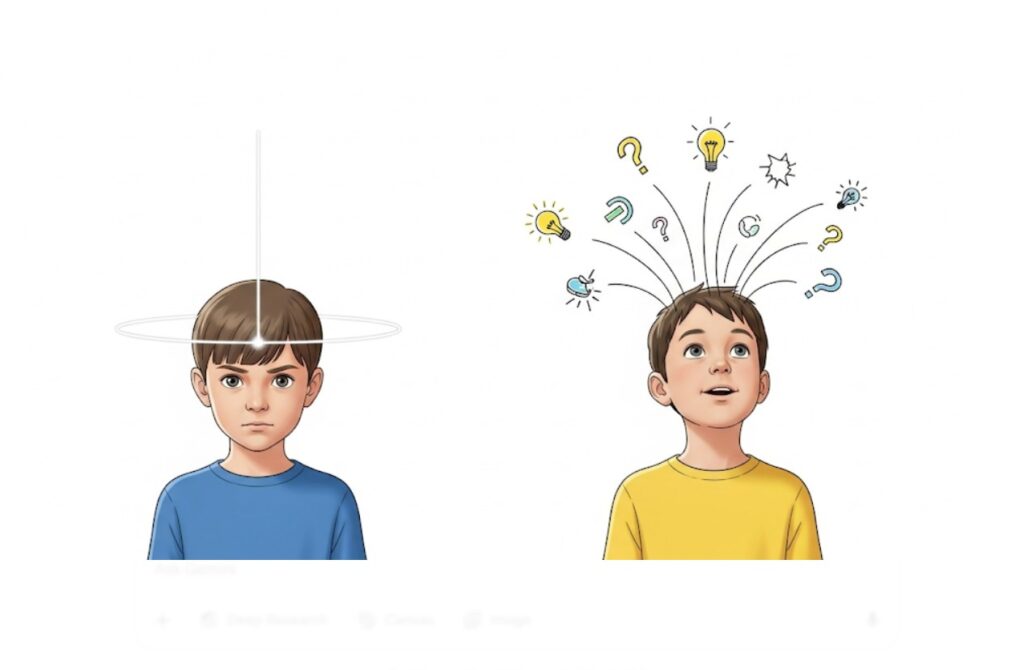Table of Contents
What is Convergent and Divergent Thinking
Convergent Thinking means that you observe something and exert your entire focus on that observation. Whereas Divergent Thinking means that the moment you observe something, your brain starts exploring on all the associated aspects related to that observation. Later part of this article will provide a Comparison of Convergent and Divergent Students.
Let me explain this with an example. Imagine a new town that does not have a pet shop and there is only one Chinese restaurant that does not provide authentic Chinese Food. Now imagine, one convergent and one divergent thinker visit this town. The convergent thinker will simply take this observation as a fact and move on with his/her life. However a divergent thinker will think the possibilities associated with this observation. For example, writing a blog on Chinese restaurants, starting a new business of pets, writing a letter to Municipality Office on the need of pet shops, finding an investor to open another Chinese restaurant, speaking to the manager of restaurant for improving food quality and so on.
I hope by now you would have understood the difference between convergent and divergent thinking. Just like the above example of two people, students also fall under convergent and divergent thinking categories. So, let us read some key points with regards to both categories of students:

Comparison of Convergent and Divergent Students
- Convergent students usually take the information as is. Their thinking pattern is limited hence they lack thinking beyond the information available in their course books.
- Convergent students possess low critical thinking skills hence they are poor decision makers in life.
- Convergent students lack creativity hence they don’t progress well if their profession requires designing new stuff or trying innovative ideas.
- Convergent students usually score good in exams because they memorize the course contents. Especially, in South Asian countries, these students outshine because their grades are based on memorization skills and not on the deep understanding of the contents.
- Convergent thinkers may perform well in Audit firms, Quality Control jobs however they still lack innovation and out of box thinking.
- Divergent students may not be the toppers however they become better thinkers, better decision makers and good leaders.
- Divergent students are fast learners and due to this skill their life-learning process is faster than those of convergent students. Divergent students enhance their wisdom levels due to their diverse thinking patterns.
- Divergent students possess good analytical skills. They think beyond the academics.
- Some of the scholars think that convergent thinking is based on logic and requires to-the-point focus, whereas divergent thinking is about creativity and diversification of the subject. Hence it is not fair to state that only divergent thinking is required to succeed in life.
Auto Amazon Links: Could not resolve the given unit type, . Please be sure to update the auto-insert definition if you have deleted the unit.

Conclusion and Recommendations
After having this deep dive on convergent and divergent thinking, here are some recommendations:
Nurturing Independent Thinkers: Empowering Children Beyond Rote Learning
Encourage Thoughtful Discussions in Classrooms
Teachers should actively encourage students to share their thoughts after completing a specific chapter or lesson. This simple habit can ignite their thinking patterns, prompting them to reflect, question, and articulate their ideas. Instead of merely absorbing content, students begin to process information critically — a foundational skill for lifelong learning.
A classroom that values open discussion fosters confidence, curiosity, and creativity. It teaches students that their opinions matter and that thinking differently is not only accepted — it’s encouraged.
Involve Children in Real-Life Conversations at Home
Parents play an equally important role in strengthening their children’s observation and communication skills. They can do this effortlessly by asking open-ended questions when:
- Visiting a shop or mall
- Watching a YouTube video together
- Reading a book or school lesson at home
These small moments are powerful opportunities to teach children how to observe, analyze, and express their thoughts — essential traits of emotionally and intellectually developed individuals.
Correct Without Discouraging
If a child’s understanding of a topic is incorrect, avoid harsh corrections or mockery. Instead, praise the child for thinking independently and gently guide them toward the correct answer.
Scolding or belittling a child for a wrong answer — especially over minor matters — can deeply damage their self-esteem. Over time, this may lead them to suppress their opinions, remain silent in group discussions, or fear asking questions. Such children often grow into adults with weakened confidence and a constant fear of judgment.
Move Beyond Traditional Teaching Methods
Traditional teaching techniques that focus heavily on memorization and exam scores often fail to prepare students for real-world challenges. While rote learning may help pass tests, it does little to develop critical thinking, creativity, or decision-making skills.
It’s time schools shun outdated methods and embrace modern, student-centric teaching strategies that:
- Encourage brainstorming and open-ended discussions
- Promote project-based learning
- Introduce case studies and real-world simulations
These approaches not only enhance academic performance but also foster personal growth and problem-solving abilities.
Comparison of Convergent and Divergent Students
Understanding the difference between convergent and divergent thinkers helps teachers and parents support learning in more meaningful ways:
- Convergent students focus on finding the one “correct” answer — they’re logical, analytical, and structured.
- Divergent students think creatively and explore multiple possibilities — they’re imaginative, open-minded, and innovative.
Both thinking styles are valuable. A balanced education system nurtures both, allowing students to use logic when needed and creativity when possible.
Design Smarter Home Assignments
Homework should not just be a repetition of classwork. Instead, assignments should be designed to spark curiosity and encourage interaction. For example:
- Ask students to interview family members or neighbors about a topic
- Assign research that requires using the internet or watching a documentary
- Encourage small group discussions before submitting answers
This approach promotes exploration and ensures that learning extends beyond textbooks into the real world.
Empower Kids with Diverse Personality Traits
The ultimate goal of education is not just academic success — it’s to raise well-rounded, compassionate, and capable human beings. Parents should actively work to develop traits like:
- Confidence
- Assertiveness
- Empathy
- Resilience
- Honesty
- Curiosity
Empowering kids emotionally and mentally prepares them not only to excel in academics but also to lead meaningful, successful lives.




